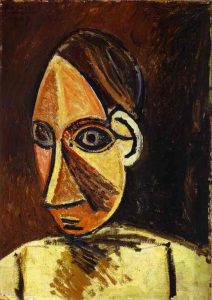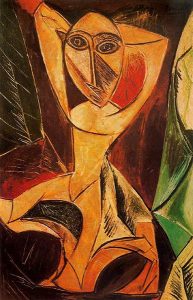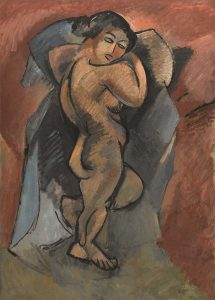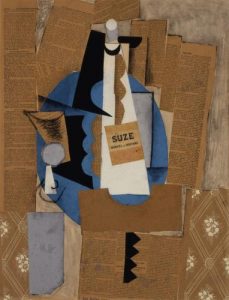The aim of this art history essay is to discuss the ways in which primitive, African art affected the style and subject matter of the cubist art movement.
Cubism is considered as ‘art of abstraction’ which makes reference to the visible world but doesn’t copy it. It depicts real forms in a simplified way – keeping only an allusion of the original natural subject. Cubism originated from Pablo Picasso and Georges Braque in 1907. Their style was heavily influenced by post impressionist artist Paul Cezanne, who’s later work starts to depict the multiple perspectives that defined the cubist period. The cubists felt that the traditions of western art in which subject-matter and style had been depicted had been unchanged since the renaissance and they believed a new challenge was needed to revitalise the conventional methods set by the academy. Most of the cubists were attracted by the anarchist philosophy, and they wanted to create art that would shock the academy, critics and public.
About this time Paul Gauguin had travelled to Tahiti were he painted the natives and their natural surroundings, this in itself was revolutionary as no other western artist had explored to such a depth geographically or artistically. Primitive art was not greatly known outside the African continent but other artists were also beginning to notice these cultural differences. So with the new perception on painting from multiple viewpoints and the opportunities of new cultural experiences, the cubists became extremely enthusiastic about re-inventing 20th century art.
1(Georges Braque recalled that ‘negro masks… opened a new horizon for me. They made it possible for me to make contact with instinctive things, with uninhibited feeling that went against the false tradition [late western illusionism] which I hated’). The simplified shapes and lack of concern with realist depiction of the sculptures attracted them to including and incorporating this style into their own work.
The sculptures and the masks of the primitive have a lot of religious meaning to the native people; the westerners were not however, interested in the religious symbolism of these cultural artefacts.
2(‘Apollinaire remarked: ‘in negro sculpture, no account is taken of the supernatural character with which it is endowed by the artists, who have created it and the faithful who worship it”) Westerners viewed Africa as the symbol of savagery. The cubists, however, saw this as a refreshing source but merely valued their expressive style and abstract forms.
3(“His [Picasso] interpretation of African art, in these mask-like faces, was based on this idea of African savagery; his brush-strokes are hacking, impetuous, and violent”). Picasso was able to convey his personal feelings and views about the primitive culture through his dramatic art work.
Maurice Vlaminck sold an African mask to Derain who, in turn, introduced it to Picasso. 4(“…Derain was ‘speechless’ and ‘stunned’ when he saw it … Picasso and Matisse, who were also greatly affected by it.”) This was the first time Picasso had seen such unusual art. He later went to an exhibition at the Ethnographic Museum of the Trocadero in Paris, which intrigued him further. The 19th century Fang sculpture (below) is similar to what Picasso saw just before he painted Les Demoiselles D’ Avignon in 1907. It is notably Picasso’s first art works to be influenced by primitive art. Perhaps being the most revolutionary painting of the 20th century by breaking with traditions of the past. It is considered the ‘birth’ of cubism.
Picasso, Les Demoiselles D’ Avignon, 1907.

The young ladies of Avignon (translated in to English) is of five prostitutes in a Barcelona brothel, painted after Picasso had made many visits to a brothel, the women seductively invite the viewer but their faces are thought to symbolise the physical effects of syphilis. 5(“Given Picasso’s pathological fear of venereal disease, the masked figures can be interpreted as being harbingers of this”) This painting was so profound because it was unlike anything anyone had ever seen before. 6(“Picasso recognised how radical it was and for several years he only showed it to a few close friends, most of whom were confused and shocked by what they saw”).
The painting was not actually exhibited until 1916, but it was still seen of as immoral when it was viewed. There is no perspective, no modulated colours and it is made up of abstract simplifications. After painting Les Demoiselles D’ Avignon, Picasso began to paint in a style that was influenced by the two figures on the right side of the painting which have a distinct resemblance to the African mask. The shape of the head, nose, even the eyes and mouth all share a likeness for the mask, this painting is also said to have initiated the so-called ‘negro period’ (1907-1908).
Picasso, Head of Woman, 1907

Dan Mask
This is one of Picasso’s ‘negro period’ paintings, there are very clear similarities between the two, the shape of the head, which is an elongated oval, the facial features, being the prominent large nose, sunken eyes, raised eyebrows and small mouth, even the colours are extremely alike . Picasso starts to use a very narrow colour spectrum during this time; this is because the Africans used natural materials like wood, which inspired the cubists to mainly concentrate on the natural brown, yellow and green earth tones. The effect of these colours is to create a sense of the organic, adding to the primitive feel. You can see the painterly brushstrokes and there is little use of modulated colour.
Picasso, Nude with raised arms, 1907

Another of Picasso’s ‘negro’ paintings, including the trademark, over sized oval head, exaggerated facial features comprising of the prominent eyebrows and nose which yet again can clearly be related back to the influence of the tribal masks, the pose and general composition of this painting is typical of Picasso’s early African inspired cubist work. The use of muted, natural, earthy colours is also evident. The figure, being female, is in the centre of the painting facing the viewer with her legs apart and arms raised above and behind the head. The stare of this nude female is emotionless and without any recognisable human expression. Her body also appears to have been distorted; the limbs are not curved and jointed but seem in fact very flat and un-human like.
Georges Braque was originally an artist of the fauves but Cezanne’s influence assisted his change in direction and he began to study the different effects of light and perspective. It was then that Picasso introduced Braque to primitive art. Picasso and Braque became close over the years that followed, even though the two had very little in common in way of temperament and ideas, they were however, essential to each other; they were always challenging and encouraging each other and would often compare their work.
Georges Braque, Large Nude, 1908

This painting shows Braque’s response to his two main influences, Cezanne and Picasso. Although not immediately impressed by Picasso’s Les Demoiselles D’ Avignon. This is a somewhat less radical take on Picasso’s use of distorted planes and shallow space; nonetheless Braque began experimenting with a fragmented style and this painting can be seen as one of his earliest works in cubism. He subsequently went on to concentrate mainly on landscape and still life subjects. There are similarities to Picasso’s head of woman, the simplified, mask like facial features, painterly and exaggerated brush strokes, narrow colour spectrum and inspiration from primitive art in the cubist style.
Their style at this time is known as analytic cubism which developed between 1908 and 1912. The artists would reduced natural forms into basic geometric shapes; focusing on certain shapes to represent the natural world. 7(Cezanne wanted to “treat nature by the cylinder, the sphere, the cone” – a tree trunk may be conceived of as a cylinder, a human head a sphere, for example). The cubists developed this theory further. Analytic cubism was an analysis of the subject viewed with many different light sources and use of space. Synthetic Cubism developed later between 1912 and 1919; paper collage was used for the first time. Newspaper clippings, wallpaper, fabric, sand and sawdust were a common addition in this style of cubism; they wanted to incorporate the real world into the canvas. There was also the introduction of brighter colours and the shapes composed were of fewer and simpler forms. Primitive art really only assisted in to the development of analytic cubism, the artists had moved on to synthetic cubism and began to create art that viewed concerns with the everyday chaos of the modern world.
Picasso, Glass and Bottle of Suze, 1912 and Georges Braque, Violin and Pipe, 1913

These are both examples of synthetic cubism; they do in fact look very comparable. Picasso and Braque often found it hard to distinguish the differences between their own works. The colours still seem fairly neutral with a hint of brighter colours but there is a distinct lack of primitive influence.
So in conclusion, the cubist’s aim was to create a new approach to Western art, primitive art was used because they felt that it helped them in achieving this aim, They provided a radical alternative to the traditional Western conventions. It is clear to see how primitive art influenced and ultimately inspired the cubist artists. Pablo Picasso, notably, being the first to make visual reference to the stylistic and simplistic qualities of African art in his own work. Georges Braque, on the other hand, didn’t use the African art so obviously; he preferred to paint landscapes and still life.
He did however, take on board, the natural colours and stuck to a narrow colour spectrum. Cubist artists only really used elements of primitive art mainly when it suited their own needs. Therefore, primitive art, though not the only source of inspiration, nevertheless had a vital influence on the foundations of cubism.




